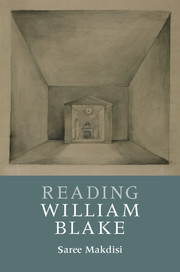1 - Image
Published online by Cambridge University Press: 05 May 2015
Summary
Two major and obvious features distinguish Blake's work from that of most other poets. The first is that for the most part it consists of both words and pictures; the second is that it exists as a heterogeneous collection of books manually produced by Blake himself. These features will mark the point of departure for our approach to Blake.
There is a catch, however – and it's the kind of catch that makes reading Blake so frustrating for some people, and so immensely exciting and rewarding for the rest of us. Actually, there are two catches.
The first catch is that neither words nor pictures in Blake's work function in what we might (even provisionally) think of as the usual way. For example, the pictures don't simply illustrate the words in the way that they often seem to in books containing pictures – and quite often they seem to have nothing to do with the words at all. Rather than thinking of the pictures as secondary, or as mere supplements to the words, then, it's more helpful to think of Blake's works as being two quasi-independent texts: a verbal one (the words) and a visual one (the images). Even this approach, though, is complicated as sometimes the images and the words in Blake's texts lose their respective distinctiveness and seem to merge into one another. Look at all those letters, on the title page of Songs of Innocence and of Experience among other places, where letters sprout tendrils and branches and take on other pictorial characteristics, making it difficult or impossible to establish a clean differentiation between words and pictures. It's most helpful, then, to think of Blake's works as constituted by and existing in the charged and ever-changing relationship between the restlessly mutating verbal and visual components of which it is composed, and even to think of the text as somehow suspended – activated, charged, turned on – in the gap between those components: a gap that every reader traces in a different way with every encounter with the work.
- Type
- Chapter
- Information
- Reading William Blake , pp. 7 - 28Publisher: Cambridge University PressPrint publication year: 2015



